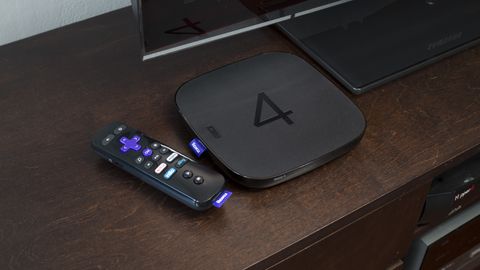TechRadar Verdict
If you own a 4K TV, the Roku 4 is hands down the best video streaming system money can buy, offering more options than any one competitor. If you don't need Ultra-HD and still want some of the same amazing OS, consider stepping down to a Roku 2 or 3.
Pros
- +
Quad-core processor for 60fps 4K
- +
Most egalitarian OS
Cons
- -
Still pushes M-Go
- -
Audible noise and heat
Why you can trust TechRadar
The Roku 4 has big shoes to fill. It's taken years for this latest model to come out – the Roku 3, which we dubbed "the gold standard in streaming," came out back in 2013 – but the end product has justified the wait.
The new, $129 (about £85, AU$180) Roku 4 is faster, more well-rounded and more open than any product the company has released before, borrowing from its predecessor and adding more to its legacy in equal measure.
It's faster because it's sporting a new quad-core processor for 4K, 60 frames-per-second video streaming. It's more well-rounded, thanks to the universal search function that scans streaming services, like Netflix, Amazon Prime Instant Video, Vudu, YouTube, M-Go and the Google Play Store for movies and shows and displays the cheapest option first. (Of course, it will scan the UK/AU equivalents when it eventually reaches those territories.)
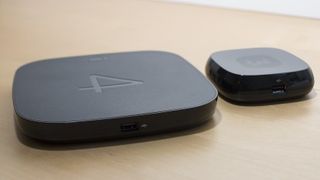
Roku is still the most egalitarian streaming set-top box of the day. It doesn't care if you pick Netflix over Amazon, or Vudu over Hulu. It doesn't want to sell you an Rdio subscription, and it couldn't care less if you join YouTube Red.
At the end of the day, all Roku's new device cares about is getting you to the content you want through the most affordable means possible. It's entertainment on your terms, the epitome of the cord-cutting movement.
Design
If the best analogy for the Roku 3 was a hockey puck, the closest sports relative of the Roku 4 would be a frisbee: it's wider, by far, but shorter overall.
The Roku 4 measures in at 0.8 x 6.5 x 6.5 inches, or 2 x 16.5 x 16.5cm (H x W x D). The flatter top allows you to stack items on top of it (the Amazon Fire TV fits perfectly, in case you're wondering), and these dimensions seem like a true feat once you learn what's under the hood.
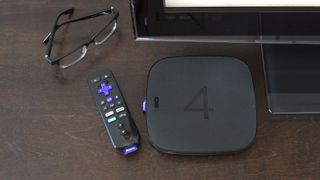
The Roku 4 is rocking a quad-core ARM processor, an 802.11ac Wi-Fi antenna and 1.5GB of RAM. All of this allows the system to play 4K TV shows and movies, however, it strangely doesn't support HDR content. There's not a lot of storage on the Roku 4 when compared to other streaming systems – there's only around 256MB. But, in its defense, games are sparse and individual channels don't take up much space on their own.
Read: Where to watch 4K TV shows and movies
Spin the system around to the back, and you'll find a new addition to the standard lineup of ports. The Roku 4 is the first streaming box from the company to house an optical audio out connection, a huge boon for A/V enthusiasts who have needed to run the HDMI cable through a soundbar or receiver before connecting it to their TV.
Other ports include an HDMI 2.0a (which supports HDCP 2.2, obviously), a USB 2.0 and 10/100 Base-T Ethernet ports. There's also a microSD card slot that will support up to 128GB of extra storage.
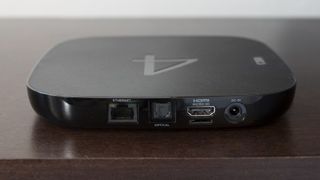
However, it's worth noting that the slimmer profile and addition of high-powered hardware have introduced two new problems that were absent in the Roku 3: heat and noise.
Even when the Roku 4 isn't playing a TV show, I hear an audible humming noise coming from the box. Now, this might not be a major concern if it's going in your living room next to some already-noisy game system, like the Xbox One or PS4. But, if it's going in your bedroom or a quiet spot in the house, prepare for a faint "bzz" sound all hours of the day. Interestingly, the Roku 4 is noticeably hotter than any other device in my media cabinet.
Neither of these were deal breakers once I had my favorite shows and movies on the screen (even though, at times, I can hear the device over the sound of the TV), but they're something to be prepared for.
The Roku 4 remote
If you've used a Roku 2 or a Roku 3 remote, you'll be intimately familiar with what to expect on the Roku 4. The Roku 4's remote is almost identical to the Roku 3's.
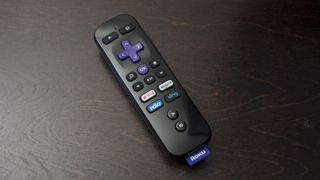
The major differences are that the A and B buttons have lost their color, and it no longer comes with the iconic purple wrist-strap, something that I actually quite liked about the Roku 3's pad.
The remote sports four branded buttons for quick access to Netflix, Amazon Instant Video, Rdio and Sling TV. With the exception of YouTube, these are probably the four most popular streaming services on the platform.
Also returning is the built-in microphone that supports voice search and an audio jack for private listening, with a set of volume control buttons located on the right side of the stick.
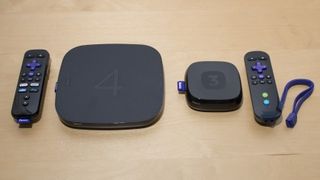
It was mentioned before in the Roku 3 review, but it's worth reiterating that the remote's built-in amplifier really isn't powerful enough for high-end headphones. (Earbuds are your best bet.)
The last feature worth pointing out is the remote-finder button, located on the back of the box. Anytime you lose the remote between the cushions, you can press the button to cause the remote to emit a customizable tone. The tones can be changed from the settings menu found inside the gorgeous new 1080p interface, which is up next.
Before you can check out the snazzy new interface or take on the world of Ultra-HD streaming, you'll first need to set up your unit.
The Roku 4 setup process
If you're new to Roku, you'll be forced into creating an account before you can get anywhere. The account setup only takes a few seconds and is incredibly simple, however it does require you to input a credit card, which allows for easy debiting should you decide to shell out for pay-to-view content.
I understand the reasoning behind entering the credit card information, but it seems unnecessary if you already pay for services like Netflix, Hulu or Amazon Prime and don't have any intention to spend money on content.
Existing Rokuites upgrading from second or third generation units can simply authorize the box online and add it to their inventory, and the process takes but a few minutes.
Nick Pino is Managing Editor, TV and AV for TechRadar's sister site, Tom's Guide. Previously, he was the Senior Editor of Home Entertainment at TechRadar, covering TVs, headphones, speakers, video games, VR and streaming devices. He's also written for GamesRadar+, Official Xbox Magazine, PC Gamer and other outlets over the last decade, and he has a degree in computer science he's not using if anyone wants it.
